Public opinion in most countries seem to favor renewables as the future source of carbon-free power. Nuclear power is often regarded as a thing of the past, and an option that is “too expensive” or “too risky” to replace coal. In reality, when we put our money into renewables, we snatch defeat from the jaws of victory.
Renewables don’t get us far enough
These perceptions is one of the main reasons that the EIA International Energy Outlook 2013 has global electricity production doubled in the year 2014, with relations between power sources virtually unchanged. I.e. everything doubles, including coal/gas:
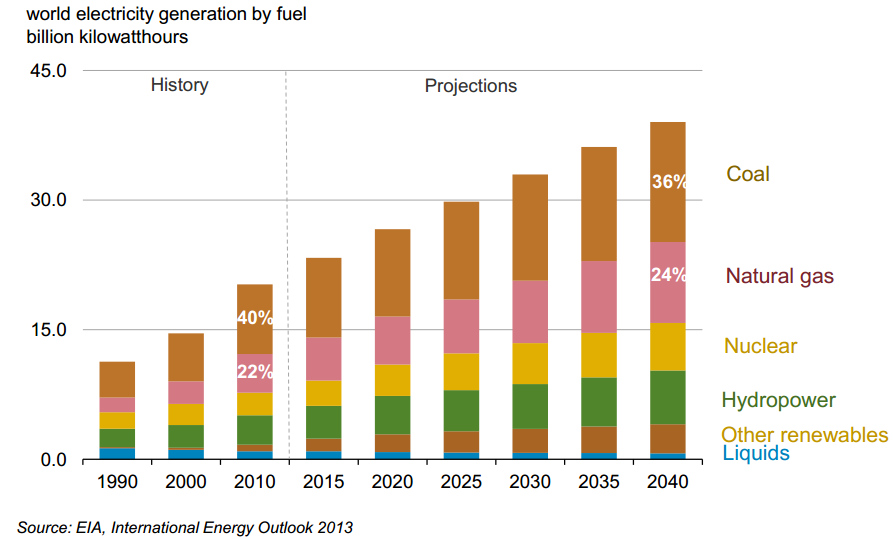
This prognosis puts the hopes of the renewables’ crowd to shame. Nuclear power remains the only proven option to combat fossil generation, but its growth is severely hampered by the ever-increasing and largely unnecessary regulatory burdens.
Pace of technology adoption
In the graph below, with data mostly from the BP Statistical Review of World Energy 2013, the rapid pace of nuclear penetration in pioneer countries is obvious. When you get off the starting blocks with nuclear, 50% or more can be reached in a mere decade. Just as obvious is the comparatively slow pace of wind and photovoltaic adoption.
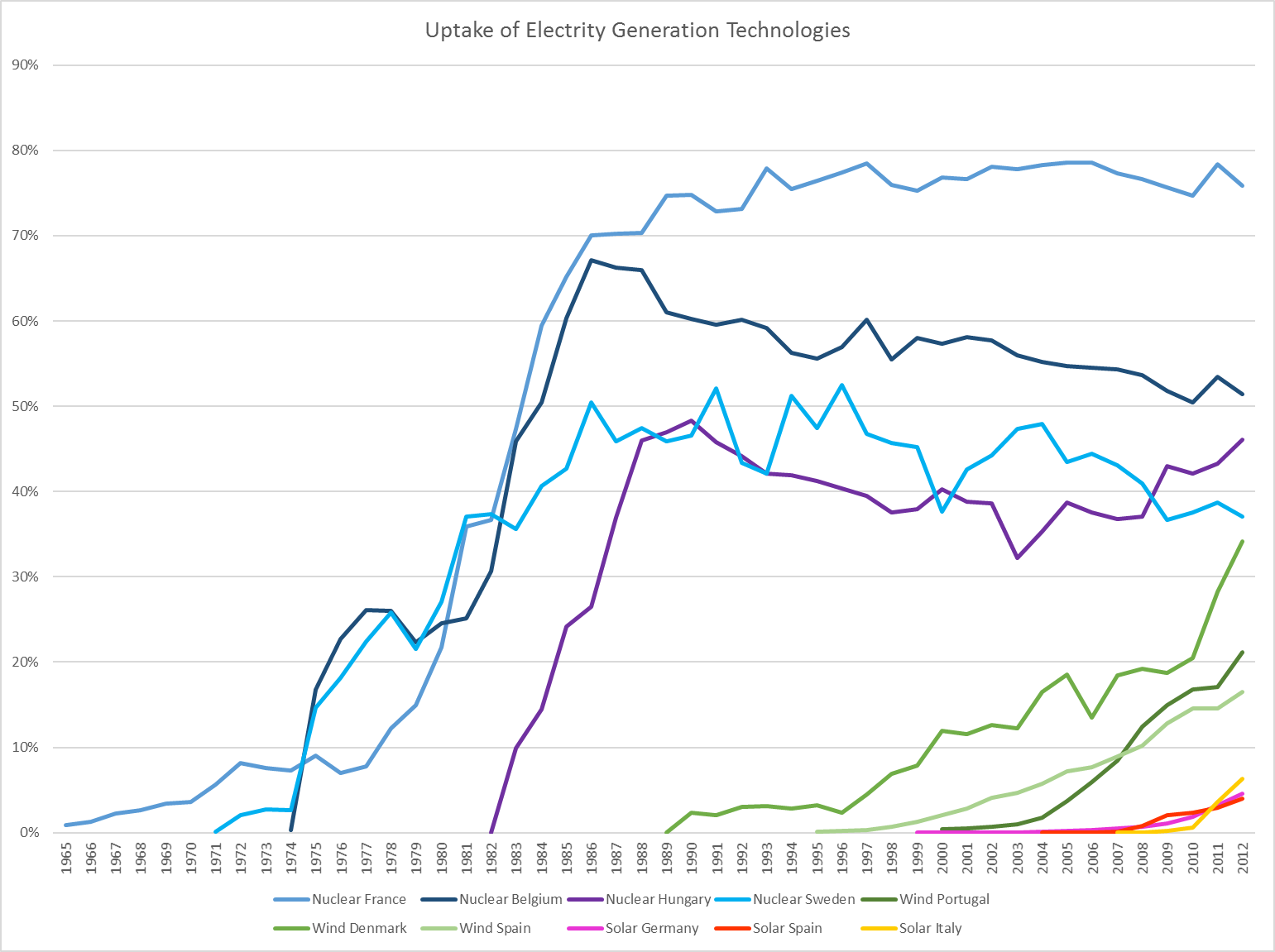
Denmark does have a fairly steep wind curve recently, but we should remember that Denmark is a very small country that relies heavily on its neighbors’ power grids for balance. Larger countries and areas such as Germany doesn’t have larger neighbors, and cannot easily integrate that much wind power.
Germany: The Black Sheep of Europe
Germany, the major industrial power of Europe, is the prime example of energy policy gone totally wrong. Last year, it actually increased its coal generation by 3.9%, from 76.0 million tonnes of oil equivalent (MTOE) to 79.2 MTOE. Half of the electricity of Germany is from coal, but it could have been rid of all of it already, had it pursued nuclear power instead of wind and solar. Here’s a table of German investment costs:
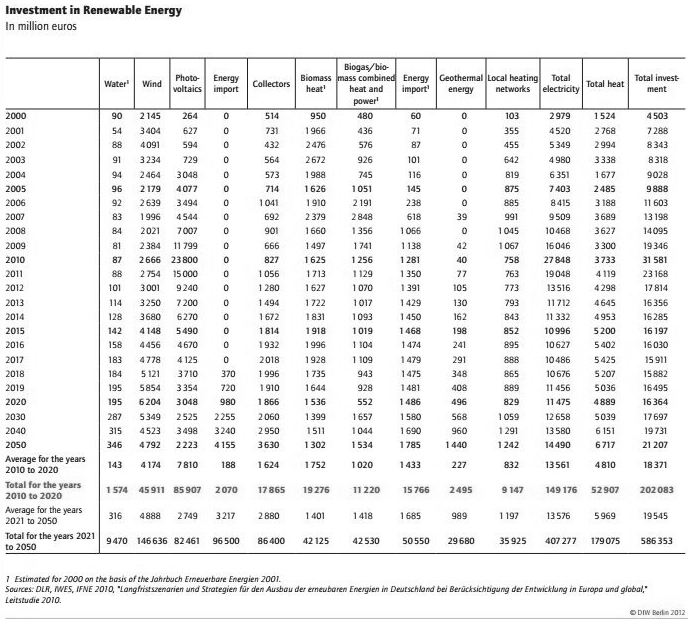
As can be seen, electricity investments in renewables amounted to a whopping 60 billion euros from 2000 until 2008. That money could have built them 15 nuclear reactors with an output of some 140 TWh/year already completed today. The investments from 2009-2012, ie 76 billion euros, would suffice for an additional 19 reactors with an output of some 180 TWh to be completed in the coming few years. Instead of these 140+180 = 320 TWh/year of electricity for 60 years of lifetime, Germany now has 60 TWh/year of wind and photovoltaics with 20 years of life. Germany’s coal generation is some 280 TWh/year, so had the money been put into nuclear, the coal would soon be history.
Consequences of failed policy
What’s more, had Germany pursued the nuclear path, they wouldn’t have locked in a FiT surcharge of 5 euro cents or more per kWh for many years to come, and unneccessary cancer deaths would be down by thousands each year! Note: This does not include costs that are external to intermittent power sources, for strengthened grids and for industries to create power backup solutions to handle frequency fluctuations. And, of course, hundreds of million tonnes of CO2 wouldn’t have been released into the atmosphere.
The Future
Renewables investment in Germany, for electricity only, from 2010-2050 in the table above is put at a staggering 149+407=556 billion euros (there are higher estimates up to a trillion euro). This excludes transmission upgrades, backup power plants, demand side managements costs, industry consequences and more, yet it would suffice to build some 140 nuclear reactors that would produce 1300 TWh/year – probably more considering economies of scale. Germany today consumes 600 TWh/year and wants to cut that with 25% in order to reach its goals.
While there are signs that Germany’s consumers, voters and politicians doesn’t have the stamina to continue on this painful and polluting path for long, some of it, as EIAs projection shows, will be replicated in the rest of the world. The world could get rid of coal in short order, if it puts its money on the right horse. Will public opinion and regulatory regimes allow that? You decide!
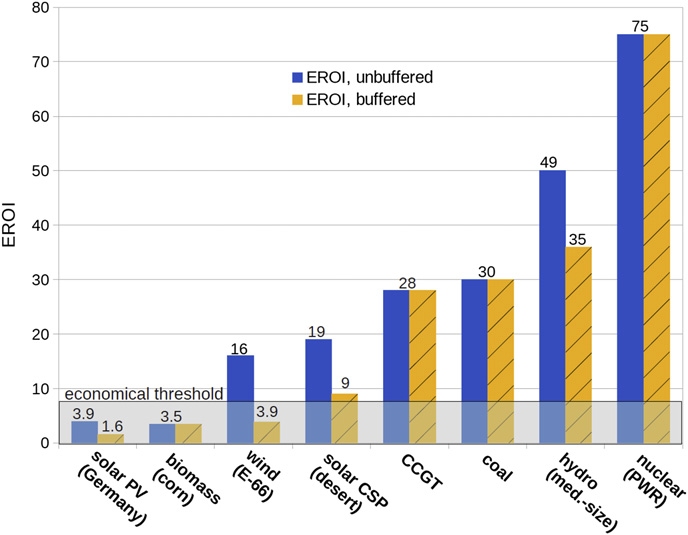

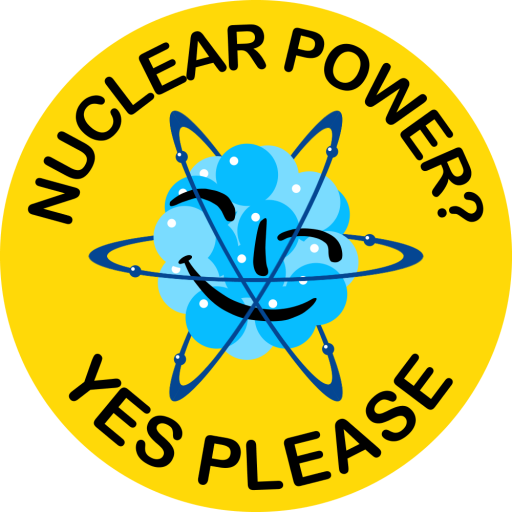
Losing the battle against coal
Published by jeppen on July 28, 2013Public opinion in most countries seem to favor renewables as the future source of carbon-free power. Nuclear power is often regarded as a thing of the past, and an option that is “too expensive” or “too risky” to replace coal. In reality, when we put our money into renewables, we snatch defeat from the jaws of victory.
Renewables don’t get us far enough
These perceptions is one of the main reasons that the EIA International Energy Outlook 2013 has global electricity production doubled in the year 2014, with relations between power sources virtually unchanged. I.e. everything doubles, including coal/gas:
This prognosis puts the hopes of the renewables’ crowd to shame. Nuclear power remains the only proven option to combat fossil generation, but its growth is severely hampered by the ever-increasing and largely unnecessary regulatory burdens.
Pace of technology adoption
In the graph below, with data mostly from the BP Statistical Review of World Energy 2013, the rapid pace of nuclear penetration in pioneer countries is obvious. When you get off the starting blocks with nuclear, 50% or more can be reached in a mere decade. Just as obvious is the comparatively slow pace of wind and photovoltaic adoption.
Denmark does have a fairly steep wind curve recently, but we should remember that Denmark is a very small country that relies heavily on its neighbors’ power grids for balance. Larger countries and areas such as Germany doesn’t have larger neighbors, and cannot easily integrate that much wind power.
Germany: The Black Sheep of Europe
Germany, the major industrial power of Europe, is the prime example of energy policy gone totally wrong. Last year, it actually increased its coal generation by 3.9%, from 76.0 million tonnes of oil equivalent (MTOE) to 79.2 MTOE. Half of the electricity of Germany is from coal, but it could have been rid of all of it already, had it pursued nuclear power instead of wind and solar. Here’s a table of German investment costs:
As can be seen, electricity investments in renewables amounted to a whopping 60 billion euros from 2000 until 2008. That money could have built them 15 nuclear reactors with an output of some 140 TWh/year already completed today. The investments from 2009-2012, ie 76 billion euros, would suffice for an additional 19 reactors with an output of some 180 TWh to be completed in the coming few years. Instead of these 140+180 = 320 TWh/year of electricity for 60 years of lifetime, Germany now has 60 TWh/year of wind and photovoltaics with 20 years of life. Germany’s coal generation is some 280 TWh/year, so had the money been put into nuclear, the coal would soon be history.
Consequences of failed policy
What’s more, had Germany pursued the nuclear path, they wouldn’t have locked in a FiT surcharge of 5 euro cents or more per kWh for many years to come, and unneccessary cancer deaths would be down by thousands each year! Note: This does not include costs that are external to intermittent power sources, for strengthened grids and for industries to create power backup solutions to handle frequency fluctuations. And, of course, hundreds of million tonnes of CO2 wouldn’t have been released into the atmosphere.
The Future
Renewables investment in Germany, for electricity only, from 2010-2050 in the table above is put at a staggering 149+407=556 billion euros (there are higher estimates up to a trillion euro). This excludes transmission upgrades, backup power plants, demand side managements costs, industry consequences and more, yet it would suffice to build some 140 nuclear reactors that would produce 1300 TWh/year – probably more considering economies of scale. Germany today consumes 600 TWh/year and wants to cut that with 25% in order to reach its goals.
While there are signs that Germany’s consumers, voters and politicians doesn’t have the stamina to continue on this painful and polluting path for long, some of it, as EIAs projection shows, will be replicated in the rest of the world. The world could get rid of coal in short order, if it puts its money on the right horse. Will public opinion and regulatory regimes allow that? You decide!
Comments closed